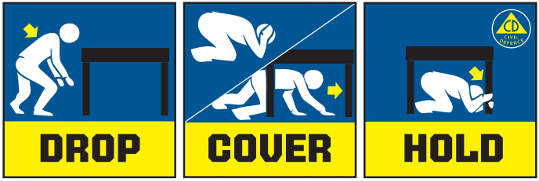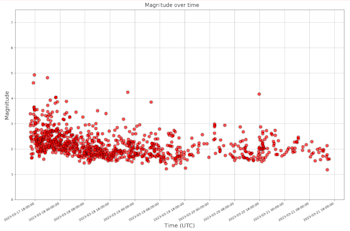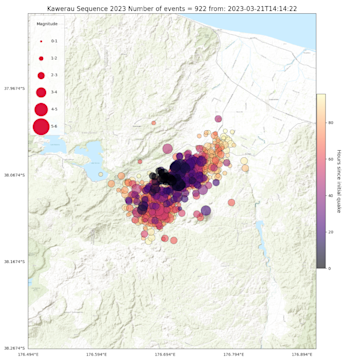
What’s happening with the Kawerau earthquake swarm?
As of 9:00am this morning, 922 earthquakes have been recorded in the swarm that began in Kawerau on Saturday. Of those, seven were magnitude (M) 4+ with the last of those a M4.2 occurring at 4:48am on Tuesday.
While it is too soon to say with any certainty, the swarm does appear to be tapering off, which is what the science team suggested may happen within a matter of days or weeks.
This magnitude over time graph plots the 922 earthquakes that have occurred since Saturday.
While a decreasing earthquake count is being observed and a continuing downward trend remains the most likely scenario, GNS Seismic Duty Officer, John Ristau cautions any premature celebrations.
“We expect an overall decrease in frequency of these earthquakes over time, but we have no way of knowing that for sure,” John says.
“As scientists and earthquake experts, it is natural for people to expect we have all the answers – but the reality is, no one in the world can predict earthquakes – we can only forecast them. We think this swarm will dissipate and we are currently seeing evidence of that, but we could still see that change.”
“We recognise it is disconcerting, but our best professional advice is to always be prepared, and use this time to ensure your whanāu, and your home and workplace is earthquake-ready.”
Earthquake swarms are a collection of quakes about the same size, happening in a localised area, usually over a short time period. Swarms usually don’t have a mainshock or larger quake that starts off a sequence.
This cumulative map shows the magnitude of the quakes depicted by size of the quake ‘dot’ and the colour depicts the time it was recorded in relation to the first earthquake recorded in the swarm.
In the Kawerau region, similar swarms to those currently being experienced occurred in 2018 and 2019. Both lasted for several days and comprised several hundred recorded earthquakes. Earthquake swarms are actually a common feature of the Central Volcanic Region in New Zealand, although swarms with the number of M4 events we are currently seeing in Kawarau are relatively infrequent. Our experts believe this swarm is due to the movement of active faults and is not related to volcanic unrest or geothermal activity.
During earthquakes we often think about shaking and its impacts on our homes, properties and infrastructure, but there are other things to consider too – like ground movement causing landslides, and tsunamis on lake and sea shores.
Earthquakes can impact unstable ground, for example areas that may have been damaged by the recent flooding and be more susceptible to earthquake activity. Landslides are possible and homes near hills or steep slopes are most at risk – so if that’s where you live, watch out for cracks or movement that could be a warning sign, and report any concerns to your local Council.
New Zealand coastlines and even lakes are at risk of tsunami. If you are at the sea or lake edge and feel strong ground shaking, hear a loud boom, or notice unusual wave conditions, act immediately and move to higher ground or get inland as soon as possible when it is safe to do so.
The National Geohazards Monitoring Centre at GNS Science keeps a 24/7 watch on the four main perils in Aotearoa – earthquakes, landslides, tsunami, and volcanoes – and will be continuing to follow this earthquake swarm activity closely. You can follow along too on the GeoNet app where every recorded earthquake is posted. You can register if you felt an earthquake and detail the shaking you felt.
Earthquakes can happen anytime and anywhere, so it is always good to be prepared. Here is some great advice for you and your whanāu. Remember to drop, cover and hold in an earthquake and follow advice from your local Civil Defence team. Information is provided on their website here
We know ongoing earthquake activity is unsettling, and people often want to know all they can about what is going on. If you want more information, be sure to keep an eye on the GNS Science advice provided on the GeoNet app, social media platforms and GeoNet website news. Some great advice and answers to your questions are available in our previous story here
Remember in an earthquake to Drop, Cover and Hold

Remember Long or Strong, Get Gone : If you are near the coast and feel a strong earthquake that makes it hard to stand up OR a weak rolling earthquake that lasts a minute or more move immediately to the nearest high ground or as far inland as you can, out of tsunami evacuation zones.
Know what to do?
The National Emergency Management Agency (NEMA) has a great website with information on
what to do before, during and after an earthquake.
Has your property suffered damage?
If you’ve got damage from the recent earthquake, care for your whānau’s safety first, take photos of any damage,
and call your private insurer. Find out more about insurance and claims on the
Natural Hazards Commission Toka Tū Ake website.
Media Contact: 021 574 541 or media@gns.cri.nz




